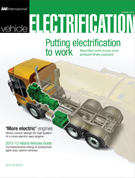Magazine

Tech Briefs: September 2018
2018-09-01
Enhanced SATCOMs for Unmanned Aerial Systems The Bus Too Tough to Die Combating Infrared Threats on the Battlefield Optical Interconnect Design Challenges in Space High-Performance Computing for the Next-Generation Combat Vehicle Merging Antenna and Electronics Boosts Energy and Spectrum Efficiency Integrated Magneto-Optical Devices for On-Chip Photonic Systems Development of magneto-optical (MO) materials could lead to a range of nonreciprocal optical devices for emerging standardized photonic integrated circuit (PIC) fabrication processes. Low Power Optical Phase Array Using Graphene on Silicon Photonics Electrostatic doping of 2D materials embedded in waveguides could enable ultrafast devices with unprecedented power. Spatial Resolution and Contrast of a Focused Diffractive Plenoptic Camera New technology captures spectral and spatial information of a scene in one snapshot while raising pixel counts and improving image quality.



















